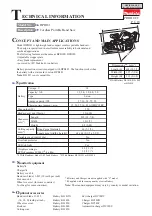
24
Identification & Description of the Saw Table...
Saw table
This is the actual machine, it comprises a cast iron table with the cut-out
(See fig A)
to allow the saw blade to project through, the two slots into which the
small mitre fence can be fitted. The edges of the table have various
combinations of drilled and tapped holes to allow the mounting of the
extension tables and the fence mounting rails; the saw assembly and the
motor are bolted to the underside of the table. The saw assembly
comprises the saw shaft with its rise and fall and tilt mechanism. The
drive is provided by the motor pulley via a drive belt to the saw shaft.
The saw table is bolted into the tops of the legs of the Upper Chassis
using 4 adjustable bolts and locking nuts to enable the table to be set
correctly. The table has been factory set, and unless it is significantly
'out' should not be adjusted.
Upper chassis
The Upper Chassis comprises 4 steel fabricated legs and 4 pressed
(See fig A)
steel panels bolted in position between them. The two upper side
panels are mounted to the chassis frame such that they can be
removed, to allow access to the saw assembly, the motor, the drive belt
etc.; these panels are each held in position by 6 caphead bolts. The
Front panel has two cutouts for the rise and fall drive shaft and the
locking mechanism actuator to come through. The cutout for the rise
and fall shaft has a decal applied to the lower edge to enable the angle
of the saw tilt to be read off, using an index pointer mounted on the saw
mechanism.. The front right leg mounts the drive shaft for the tilt system.
The NVR ON/Off Switch plate is mounted on the upper left front leg.
Lower chassis
This comprises a further 4 steel fabricated legs and 4 pressed steel
(See fig A)
panels bolted in position between them. The lower rear panel has a
cutout to allow the mounting of the dust extraction moulding.
Table insert
This is a metal alloy insert that covers the hole in the saw table through
(See fig A)
which the blade protrudes, and which allows access to the inside of the
saw table, to enable the riving knife to be adjusted, the saw blade to be
changed, et al. The left side of the gullet has been relieved so that the
saw blade can be tilted.
Extension tables
The cast iron extension tables provide added support for the workpiece
(See fig A)
beyond the boundaries of the saw table to the rip side.
Extension table
Because of the weight of the extension leaves, a support leg is provided
support leg
to increase stability. The height adjustment is effect by loosening the
(See fig A)
caphead bolt and allowing the inner channel to slide in the outer
channel. Tighten the bolt to lock the leg at the height selected.
Rise and fall
This is an engineers wheel handle attached to the shaft of the rise and
control hand
fall mechanism of the saw. Turning the handle clockwise will cause the
wheel
saw blade to fall, anti-clockwise to rise. Rotate control behind clockwise
(See fig A)
to lock spindle.
Tilt angle
A small star knob situated above the rise and fall control handle that
lock
locks the tilt mechanism to prevent any movement that could be caused
(See fig A)
by vibration during the saw operation.
Содержание MJ2325D
Страница 1: ...10 Sliding Table Saws User Manual For your safety please read this manual carefully before operation ...
Страница 3: ......
Страница 4: ......
Страница 8: ...E ...
Страница 9: ......
Страница 10: ......
Страница 21: ......
Страница 23: ......
Страница 24: ...36 Parts List Breakdown for the 10 Saw Table DIAGRAM A ...
Страница 25: ...37 Parts List Breakdown for the 10 Saw Table ...
Страница 26: ......
Страница 27: ...DIAGRAM B 39 Parts List Breakdown for the 10 Saw Table ...
Страница 28: ...40 Parts List Breakdown for the 10 Saw Table DIAGRAM C ...
Страница 29: ...42 Parts List Breakdown for the 10 Saw Table ...
Страница 30: ...DIAGRAM D 43 Parts List Breakdown for the 10 Saw Table ...
Страница 31: ...44 Parts List Breakdown for the 10 Saw Table DIAGRAM E ...
















































